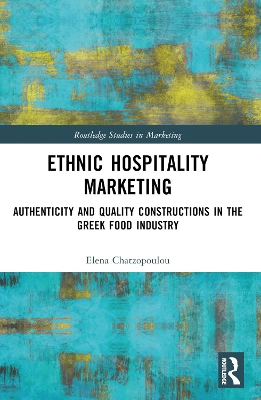Ethnic Hospitality Marketing
 portes grátis
portes grátis
Ethnic Hospitality Marketing
Authenticity and Quality Constructions in the Greek Food Industry
Chatzopoulou, Elena
Taylor & Francis Ltd
10/2024
186
Mole
9781032130729
Pré-lançamento - envio 15 a 20 dias após a sua edição
Descrição não disponível.
Chapter 1: Introduction
1.1 Introduction
1.2 Authenticity and quality meanings
1.3 The aim: Setting food in the centre of our exploration
1.4 Food as a theoretical perspective
1.5 How can marketing influence food choices?
1.5.1 Marketing and consumer values
1.5.2 Marketing communications
1.6 What's the theoretical story (food glory)?
Chapter 2: Literature review
2.1 Introduction
2.2 Perspectives of authenticity
2.3 Food meanings and authenticity perceptions
2.4 Quality conventions and some theory behind
2.5 Self-identity and social identity: Can they influence food choices?
2.6 Ethnic identity and its influence upon food choices
2.7 Consumer culture and some theory behind
2.8 The influence of word of mouth (WOM) and e-word of mouth (eWOM) upon consumers
2.9 Network building among food providers and consumers
2.10 What makes a successful restaurant?
2.11 Summary
Chapter 3: The Greek culinary culture and its health benefits
3.1 Introduction
3.2 The Greek culinary culture
3.3 The economic context: The restaurant sector in Greece over the last years
3.4 Health benefits of the traditional Mediterranean diet
3.5 Summary
Chapter 4: Methodology
4.1 Introduction
4.2 Why conduct a qualitative study?
4.3 Interpretivism
4.4 Grounded theory
4.4.1 Constructivist strategy
4.4.2 Clusters
4.5 Semiotics and symbolic interactionism
4.6 Choice of data collection, sampling and data analysis methods
4.7 Interview guides (in-depth and cultural interviewing)
4.8 Projective technique (word association)
4.9 Inductive reasoning
4.10 Data analysis (coding stages and Nvivo)
4.11 Respondent validation
4.11.1 Constant comparison
4.11.2 Running an event: Presenting the findings to practitioners and consumers
4.12 Ethical issues
4.13 Summary
Chapter 5: Restaurateurs' understanding of authenticity
5.1 Introduction
5.2 Restaurateurs' authenticity perceptions
5.2.1 Menu construction
5.2.2 Tradition (recipes from previous generations and not influenced by other nations)
5.2.3 Traditional cooking (slow cooking technique, cooking from scratch)
5.2.4 Hummus and other controversial dishes (adaptation to the global market)
5.2.5 Ingredients from the origin with or without PDO/PGI designation (e.g. oil, olives, herbs, feta)
5.2.6 Wine from the origin
5.2.7 The staff
5.2.8 Music
5.2.9 Decoration / atmosphere
5.2.10 Traditional entertainment (e.g. smashing plates, traditional dancing)
5.2.11 Indexical authenticity
5.2.12 Existential authenticity
5.3 Factors influencing the construction of authenticity
5.3.1 Identities and cultural familiarity
5.4 Summary
Chapter 6: Consumers' food choices and authenticity understanding
6.1 Introduction
6.2 Consumers' authenticity perceptions
6.2.1 Food and menu
6.2.2 Tradition
6.2.3 Hummus and other controversial dishes (adaptation to the market)
6.2.4 Ingredients and P.D.O. products (e.g. feta)
6.2.5 Atmosphere / decoration
6.2.6 Food quality
6.2.7 Taste
6.2.8 Staff
6.2.9 Music and entertainment
6.3 Factors influencing consumers' food choices
6.3.1 Nostalgia
6.3.2 The role of experiences
6.3.3 The restaurant owner
6.3.4 Identities
6.4 Summary
Chapter 7: The quality and authenticity network: identities, authenticity perceptions and quality conventions
7.1 Introduction
7.2 An in-depth exploration of authenticity and its perceptions
7.3 Quality conventions
7.3.1 Quality conventions for ethnic restaurants
7.3.1.1 Inspirational category
7.3.1.2 Market category
7.3.1.3 Domestic category
7.3.2 Intersection of authenticity and quality
7.3.2.1 Pragmatic iconicity
7.3.2.2 Ancestral indexicality
7.3.2.3 Innovative iconicity
7.3.2.4 Intersection points of authenticity and quality
7.3.2.5 Authenticity convention and the identity factor
7.4 Structuring a network of restaurant owners and consumers: Their communication and the word of mouth
7.4.1 Establishing a social network based on the word of mouth
7.4.2 Interessement
7.4.3 Word of mouth versus identity
7.5 Summary
Chapter 8: Discussion
8.1 Introduction
8.2 Quality and authenticity conventions of restaurant owners and consumers within the communication network of ethnic restaurants
8.3 Summary
Chapter 9: Conclusions
9.1 Introduction
9.2 Summary of key findings related to research objectives
9.3 Theoretical implications
9.4 Practical implications
References
Appendix
1. Author's notes during the interviews with restaurateurs
2. Semi-structured interview schedule for ethnic restaurant managers/owners
3. Semi-structured interview schedule for consumers of Greek ethnic restaurants
4. Menu 1 - Black font (Domestic oriented restaurant)
5. Menu 2 - Blue font (Market oriented restaurant)
1.1 Introduction
1.2 Authenticity and quality meanings
1.3 The aim: Setting food in the centre of our exploration
1.4 Food as a theoretical perspective
1.5 How can marketing influence food choices?
1.5.1 Marketing and consumer values
1.5.2 Marketing communications
1.6 What's the theoretical story (food glory)?
Chapter 2: Literature review
2.1 Introduction
2.2 Perspectives of authenticity
2.3 Food meanings and authenticity perceptions
2.4 Quality conventions and some theory behind
2.5 Self-identity and social identity: Can they influence food choices?
2.6 Ethnic identity and its influence upon food choices
2.7 Consumer culture and some theory behind
2.8 The influence of word of mouth (WOM) and e-word of mouth (eWOM) upon consumers
2.9 Network building among food providers and consumers
2.10 What makes a successful restaurant?
2.11 Summary
Chapter 3: The Greek culinary culture and its health benefits
3.1 Introduction
3.2 The Greek culinary culture
3.3 The economic context: The restaurant sector in Greece over the last years
3.4 Health benefits of the traditional Mediterranean diet
3.5 Summary
Chapter 4: Methodology
4.1 Introduction
4.2 Why conduct a qualitative study?
4.3 Interpretivism
4.4 Grounded theory
4.4.1 Constructivist strategy
4.4.2 Clusters
4.5 Semiotics and symbolic interactionism
4.6 Choice of data collection, sampling and data analysis methods
4.7 Interview guides (in-depth and cultural interviewing)
4.8 Projective technique (word association)
4.9 Inductive reasoning
4.10 Data analysis (coding stages and Nvivo)
4.11 Respondent validation
4.11.1 Constant comparison
4.11.2 Running an event: Presenting the findings to practitioners and consumers
4.12 Ethical issues
4.13 Summary
Chapter 5: Restaurateurs' understanding of authenticity
5.1 Introduction
5.2 Restaurateurs' authenticity perceptions
5.2.1 Menu construction
5.2.2 Tradition (recipes from previous generations and not influenced by other nations)
5.2.3 Traditional cooking (slow cooking technique, cooking from scratch)
5.2.4 Hummus and other controversial dishes (adaptation to the global market)
5.2.5 Ingredients from the origin with or without PDO/PGI designation (e.g. oil, olives, herbs, feta)
5.2.6 Wine from the origin
5.2.7 The staff
5.2.8 Music
5.2.9 Decoration / atmosphere
5.2.10 Traditional entertainment (e.g. smashing plates, traditional dancing)
5.2.11 Indexical authenticity
5.2.12 Existential authenticity
5.3 Factors influencing the construction of authenticity
5.3.1 Identities and cultural familiarity
5.4 Summary
Chapter 6: Consumers' food choices and authenticity understanding
6.1 Introduction
6.2 Consumers' authenticity perceptions
6.2.1 Food and menu
6.2.2 Tradition
6.2.3 Hummus and other controversial dishes (adaptation to the market)
6.2.4 Ingredients and P.D.O. products (e.g. feta)
6.2.5 Atmosphere / decoration
6.2.6 Food quality
6.2.7 Taste
6.2.8 Staff
6.2.9 Music and entertainment
6.3 Factors influencing consumers' food choices
6.3.1 Nostalgia
6.3.2 The role of experiences
6.3.3 The restaurant owner
6.3.4 Identities
6.4 Summary
Chapter 7: The quality and authenticity network: identities, authenticity perceptions and quality conventions
7.1 Introduction
7.2 An in-depth exploration of authenticity and its perceptions
7.3 Quality conventions
7.3.1 Quality conventions for ethnic restaurants
7.3.1.1 Inspirational category
7.3.1.2 Market category
7.3.1.3 Domestic category
7.3.2 Intersection of authenticity and quality
7.3.2.1 Pragmatic iconicity
7.3.2.2 Ancestral indexicality
7.3.2.3 Innovative iconicity
7.3.2.4 Intersection points of authenticity and quality
7.3.2.5 Authenticity convention and the identity factor
7.4 Structuring a network of restaurant owners and consumers: Their communication and the word of mouth
7.4.1 Establishing a social network based on the word of mouth
7.4.2 Interessement
7.4.3 Word of mouth versus identity
7.5 Summary
Chapter 8: Discussion
8.1 Introduction
8.2 Quality and authenticity conventions of restaurant owners and consumers within the communication network of ethnic restaurants
8.3 Summary
Chapter 9: Conclusions
9.1 Introduction
9.2 Summary of key findings related to research objectives
9.3 Theoretical implications
9.4 Practical implications
References
Appendix
1. Author's notes during the interviews with restaurateurs
2. Semi-structured interview schedule for ethnic restaurant managers/owners
3. Semi-structured interview schedule for consumers of Greek ethnic restaurants
4. Menu 1 - Black font (Domestic oriented restaurant)
5. Menu 2 - Blue font (Market oriented restaurant)
Este título pertence ao(s) assunto(s) indicados(s). Para ver outros títulos clique no assunto desejado.
Ethnic Restaurant;Authenticity Perceptions;Restaurant Owners;Greek Consumer;Greek Restaurant;Vice Versa;WOM;CCT;British Consumer;Food Authenticity;Quality Conventions;Greek Food;Culinary Culture;Mediterranean Diet;Social Identity Theory;Mediterranean Diet Adherence;PDO Product;Existential Authenticity;Traditional Mediterranean Diet;Arterial Blood Pressure Levels;Food Choice Motivations;Mediterranean Diet Model;Indexical Authenticity;Pine Kernels;Cheese Pies
Chapter 1: Introduction
1.1 Introduction
1.2 Authenticity and quality meanings
1.3 The aim: Setting food in the centre of our exploration
1.4 Food as a theoretical perspective
1.5 How can marketing influence food choices?
1.5.1 Marketing and consumer values
1.5.2 Marketing communications
1.6 What's the theoretical story (food glory)?
Chapter 2: Literature review
2.1 Introduction
2.2 Perspectives of authenticity
2.3 Food meanings and authenticity perceptions
2.4 Quality conventions and some theory behind
2.5 Self-identity and social identity: Can they influence food choices?
2.6 Ethnic identity and its influence upon food choices
2.7 Consumer culture and some theory behind
2.8 The influence of word of mouth (WOM) and e-word of mouth (eWOM) upon consumers
2.9 Network building among food providers and consumers
2.10 What makes a successful restaurant?
2.11 Summary
Chapter 3: The Greek culinary culture and its health benefits
3.1 Introduction
3.2 The Greek culinary culture
3.3 The economic context: The restaurant sector in Greece over the last years
3.4 Health benefits of the traditional Mediterranean diet
3.5 Summary
Chapter 4: Methodology
4.1 Introduction
4.2 Why conduct a qualitative study?
4.3 Interpretivism
4.4 Grounded theory
4.4.1 Constructivist strategy
4.4.2 Clusters
4.5 Semiotics and symbolic interactionism
4.6 Choice of data collection, sampling and data analysis methods
4.7 Interview guides (in-depth and cultural interviewing)
4.8 Projective technique (word association)
4.9 Inductive reasoning
4.10 Data analysis (coding stages and Nvivo)
4.11 Respondent validation
4.11.1 Constant comparison
4.11.2 Running an event: Presenting the findings to practitioners and consumers
4.12 Ethical issues
4.13 Summary
Chapter 5: Restaurateurs' understanding of authenticity
5.1 Introduction
5.2 Restaurateurs' authenticity perceptions
5.2.1 Menu construction
5.2.2 Tradition (recipes from previous generations and not influenced by other nations)
5.2.3 Traditional cooking (slow cooking technique, cooking from scratch)
5.2.4 Hummus and other controversial dishes (adaptation to the global market)
5.2.5 Ingredients from the origin with or without PDO/PGI designation (e.g. oil, olives, herbs, feta)
5.2.6 Wine from the origin
5.2.7 The staff
5.2.8 Music
5.2.9 Decoration / atmosphere
5.2.10 Traditional entertainment (e.g. smashing plates, traditional dancing)
5.2.11 Indexical authenticity
5.2.12 Existential authenticity
5.3 Factors influencing the construction of authenticity
5.3.1 Identities and cultural familiarity
5.4 Summary
Chapter 6: Consumers' food choices and authenticity understanding
6.1 Introduction
6.2 Consumers' authenticity perceptions
6.2.1 Food and menu
6.2.2 Tradition
6.2.3 Hummus and other controversial dishes (adaptation to the market)
6.2.4 Ingredients and P.D.O. products (e.g. feta)
6.2.5 Atmosphere / decoration
6.2.6 Food quality
6.2.7 Taste
6.2.8 Staff
6.2.9 Music and entertainment
6.3 Factors influencing consumers' food choices
6.3.1 Nostalgia
6.3.2 The role of experiences
6.3.3 The restaurant owner
6.3.4 Identities
6.4 Summary
Chapter 7: The quality and authenticity network: identities, authenticity perceptions and quality conventions
7.1 Introduction
7.2 An in-depth exploration of authenticity and its perceptions
7.3 Quality conventions
7.3.1 Quality conventions for ethnic restaurants
7.3.1.1 Inspirational category
7.3.1.2 Market category
7.3.1.3 Domestic category
7.3.2 Intersection of authenticity and quality
7.3.2.1 Pragmatic iconicity
7.3.2.2 Ancestral indexicality
7.3.2.3 Innovative iconicity
7.3.2.4 Intersection points of authenticity and quality
7.3.2.5 Authenticity convention and the identity factor
7.4 Structuring a network of restaurant owners and consumers: Their communication and the word of mouth
7.4.1 Establishing a social network based on the word of mouth
7.4.2 Interessement
7.4.3 Word of mouth versus identity
7.5 Summary
Chapter 8: Discussion
8.1 Introduction
8.2 Quality and authenticity conventions of restaurant owners and consumers within the communication network of ethnic restaurants
8.3 Summary
Chapter 9: Conclusions
9.1 Introduction
9.2 Summary of key findings related to research objectives
9.3 Theoretical implications
9.4 Practical implications
References
Appendix
1. Author's notes during the interviews with restaurateurs
2. Semi-structured interview schedule for ethnic restaurant managers/owners
3. Semi-structured interview schedule for consumers of Greek ethnic restaurants
4. Menu 1 - Black font (Domestic oriented restaurant)
5. Menu 2 - Blue font (Market oriented restaurant)
1.1 Introduction
1.2 Authenticity and quality meanings
1.3 The aim: Setting food in the centre of our exploration
1.4 Food as a theoretical perspective
1.5 How can marketing influence food choices?
1.5.1 Marketing and consumer values
1.5.2 Marketing communications
1.6 What's the theoretical story (food glory)?
Chapter 2: Literature review
2.1 Introduction
2.2 Perspectives of authenticity
2.3 Food meanings and authenticity perceptions
2.4 Quality conventions and some theory behind
2.5 Self-identity and social identity: Can they influence food choices?
2.6 Ethnic identity and its influence upon food choices
2.7 Consumer culture and some theory behind
2.8 The influence of word of mouth (WOM) and e-word of mouth (eWOM) upon consumers
2.9 Network building among food providers and consumers
2.10 What makes a successful restaurant?
2.11 Summary
Chapter 3: The Greek culinary culture and its health benefits
3.1 Introduction
3.2 The Greek culinary culture
3.3 The economic context: The restaurant sector in Greece over the last years
3.4 Health benefits of the traditional Mediterranean diet
3.5 Summary
Chapter 4: Methodology
4.1 Introduction
4.2 Why conduct a qualitative study?
4.3 Interpretivism
4.4 Grounded theory
4.4.1 Constructivist strategy
4.4.2 Clusters
4.5 Semiotics and symbolic interactionism
4.6 Choice of data collection, sampling and data analysis methods
4.7 Interview guides (in-depth and cultural interviewing)
4.8 Projective technique (word association)
4.9 Inductive reasoning
4.10 Data analysis (coding stages and Nvivo)
4.11 Respondent validation
4.11.1 Constant comparison
4.11.2 Running an event: Presenting the findings to practitioners and consumers
4.12 Ethical issues
4.13 Summary
Chapter 5: Restaurateurs' understanding of authenticity
5.1 Introduction
5.2 Restaurateurs' authenticity perceptions
5.2.1 Menu construction
5.2.2 Tradition (recipes from previous generations and not influenced by other nations)
5.2.3 Traditional cooking (slow cooking technique, cooking from scratch)
5.2.4 Hummus and other controversial dishes (adaptation to the global market)
5.2.5 Ingredients from the origin with or without PDO/PGI designation (e.g. oil, olives, herbs, feta)
5.2.6 Wine from the origin
5.2.7 The staff
5.2.8 Music
5.2.9 Decoration / atmosphere
5.2.10 Traditional entertainment (e.g. smashing plates, traditional dancing)
5.2.11 Indexical authenticity
5.2.12 Existential authenticity
5.3 Factors influencing the construction of authenticity
5.3.1 Identities and cultural familiarity
5.4 Summary
Chapter 6: Consumers' food choices and authenticity understanding
6.1 Introduction
6.2 Consumers' authenticity perceptions
6.2.1 Food and menu
6.2.2 Tradition
6.2.3 Hummus and other controversial dishes (adaptation to the market)
6.2.4 Ingredients and P.D.O. products (e.g. feta)
6.2.5 Atmosphere / decoration
6.2.6 Food quality
6.2.7 Taste
6.2.8 Staff
6.2.9 Music and entertainment
6.3 Factors influencing consumers' food choices
6.3.1 Nostalgia
6.3.2 The role of experiences
6.3.3 The restaurant owner
6.3.4 Identities
6.4 Summary
Chapter 7: The quality and authenticity network: identities, authenticity perceptions and quality conventions
7.1 Introduction
7.2 An in-depth exploration of authenticity and its perceptions
7.3 Quality conventions
7.3.1 Quality conventions for ethnic restaurants
7.3.1.1 Inspirational category
7.3.1.2 Market category
7.3.1.3 Domestic category
7.3.2 Intersection of authenticity and quality
7.3.2.1 Pragmatic iconicity
7.3.2.2 Ancestral indexicality
7.3.2.3 Innovative iconicity
7.3.2.4 Intersection points of authenticity and quality
7.3.2.5 Authenticity convention and the identity factor
7.4 Structuring a network of restaurant owners and consumers: Their communication and the word of mouth
7.4.1 Establishing a social network based on the word of mouth
7.4.2 Interessement
7.4.3 Word of mouth versus identity
7.5 Summary
Chapter 8: Discussion
8.1 Introduction
8.2 Quality and authenticity conventions of restaurant owners and consumers within the communication network of ethnic restaurants
8.3 Summary
Chapter 9: Conclusions
9.1 Introduction
9.2 Summary of key findings related to research objectives
9.3 Theoretical implications
9.4 Practical implications
References
Appendix
1. Author's notes during the interviews with restaurateurs
2. Semi-structured interview schedule for ethnic restaurant managers/owners
3. Semi-structured interview schedule for consumers of Greek ethnic restaurants
4. Menu 1 - Black font (Domestic oriented restaurant)
5. Menu 2 - Blue font (Market oriented restaurant)
Este título pertence ao(s) assunto(s) indicados(s). Para ver outros títulos clique no assunto desejado.
Ethnic Restaurant;Authenticity Perceptions;Restaurant Owners;Greek Consumer;Greek Restaurant;Vice Versa;WOM;CCT;British Consumer;Food Authenticity;Quality Conventions;Greek Food;Culinary Culture;Mediterranean Diet;Social Identity Theory;Mediterranean Diet Adherence;PDO Product;Existential Authenticity;Traditional Mediterranean Diet;Arterial Blood Pressure Levels;Food Choice Motivations;Mediterranean Diet Model;Indexical Authenticity;Pine Kernels;Cheese Pies







